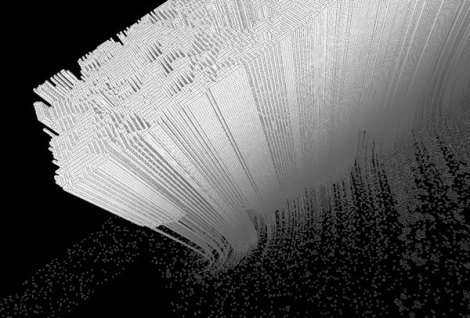Growing vs Building. The idea of growing inhabitats instead of building them still belongs to sorcerer’s apprentices but computing can give us glimpses. This is a visualization of previous cell[f] assembly code (based on Conway’s Game of Life).
The animation is coded in processing with bespoke camera angles.
Processing source code below:
import processing.opengl.*;
import toxi.geom.*;
int cols = 400;
int rows = 70;
float density = 0.97;
int MaxGeneration = 300;
int Generation =0;
int z = 0;
int[][] arrPt;
void setup() {
smooth();
size(1200, 800, OPENGL);
camera (50, 150, 300, 70, 30, 100, -1, 1, -1);
background(0);
randomGenesis(cols, rows);
}
void draw() {
Generation = Generation+1;
if ((Generation<MaxGeneration)&&(Generation>=0)) {
arrayCellTwister(arrPt, Generation);
arrPt=mutateArray(arrPt);
}
if (Generation==MaxGeneration) {
delay(500);
Generation = 0;
background(0);
randomGenesis(cols, rows);
}
}
int[][] randomGenesis(int intGridI, int intGridJ) {
arrPt = new int[intGridI+1][intGridJ+1];
for (int i = 0; i<=intGridI; i++) {
int[] arrJ;
arrJ = new int [intGridJ+1];
for (int j = 0; j<=intGridJ; j++) {
float rnd;
rnd=random(1);
if (rnd > density) {
arrJ[j]= 1;
}
else {
arrJ[j]= 0;
}
}
arrPt[i]=arrJ;
}
return arrPt;
}
void arrayCellTwister(int[][] arrPt, int z) {
for (int i =0 ;i<arrPt.length;i++) {
for (int j = 0; j<arrPt[i].length;j++) {
if (arrPt[i][j]==1) {
int[] arrCtr = {
i, j, z
};
float colorFac;
colorFac = map(z, 0, MaxGeneration, 0, 255);
noStroke();
fill(colorFac);
pushMatrix();
float swish = pow(z, 2)/10000;
rotateZ(PI/(z+swish));
translate(i+swish*10, j+swish*10, z);
box(1);
popMatrix();
}
}
}
}
int sumNeighbors(int[][] arrPt, int i, int j) {
int iOneUp = i+1;
int iOneDown = i-1;
int jOneUp=j+1;
int jOneDown=j-1;
if (i==(arrPt.length)-1) {
iOneUp=0;
}
if (i==0) {
iOneDown=(arrPt.length)-1;
}
if (j==(arrPt[i].length)-1) {
jOneUp=0;
}
if (j==0) {
jOneDown=(arrPt[i].length)-1;
}
int cellN1= arrPt[iOneDown][jOneDown];
int cellN2=arrPt[i][jOneDown];
int cellN3=arrPt[iOneUp][jOneDown];
int cellN4=arrPt[iOneUp][j];
int cellN5=arrPt[iOneUp][jOneUp];
int cellN6=arrPt[i][jOneUp];
int cellN7=arrPt[iOneDown][jOneUp];
int cellN8=arrPt[iOneDown][j];
int SumNcells = cellN1+cellN2+cellN3+cellN4+cellN5+cellN6+cellN7+cellN8;
return SumNcells;
}
int [][]mutateArray(int[][] arrPt) {
int newArrPt [][] = arrPt;
for (int i=0; i<arrPt.length;i++) {
for (int j=0; j<arrPt[i].length;j++) {
int dblNumberOfNeighbours = sumNeighbors(arrPt, i, j);
if ((arrPt[i][j]==0) && (dblNumberOfNeighbours==3)) {
newArrPt[i][j]=1;
}
else if ((arrPt[i][j]==1) && (dblNumberOfNeighbours>3)) {
newArrPt[i][j]=0;
}
}
}
return newArrPt;
}
